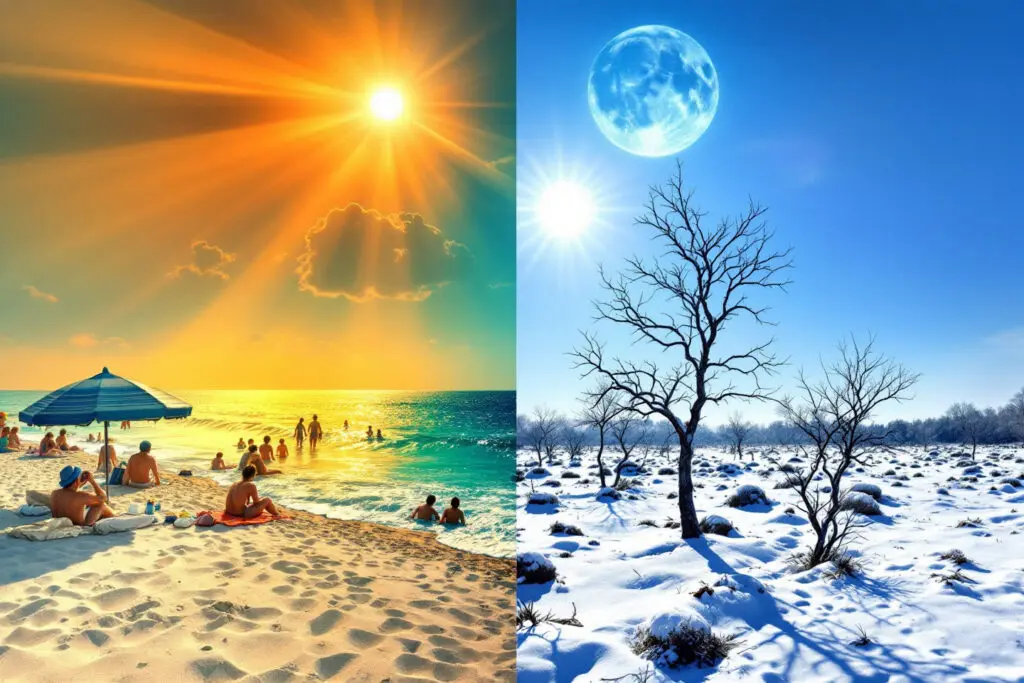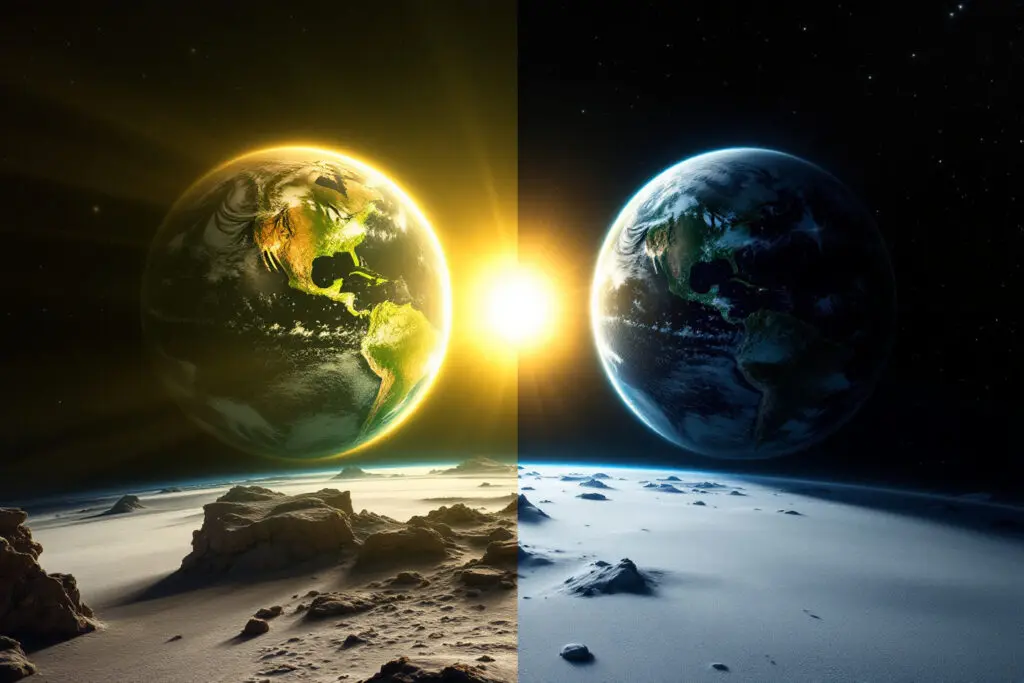Ever notice how a December afternoon sun seems to just skim the horizon, even at noon? Or how a summer evening can stretch on, refusing to surrender to the night? These aren’t just random quirks of the calendar. They’re the product of a grand celestial dance, and at the very center of it all is the solstice. If you want to understand why our world shifts so dramatically from season to season, you first have to understand this one, powerful moment.
For most of us, the changing of the seasons feels gradual, almost magical, but it’s all kicked off by a precise astronomical event. This is the complete explainer on how a solstice changes the seasons, a deep dive into the science behind nature’s biggest shift. It’s a story of tilt, light, and time.
More in The Observer’s Sky Category
Importance of the Nadir in Astronomy
Why Do Planets Follow the Ecliptic
Key Takeaways
- It’s All About the Tilt: The real reason for seasons is the Earth’s 23.5-degree tilt on its axis. It’s not about how close we are to the sun. This lean means some parts of the Earth get a direct blast of sun while others get a glancing blow.
- A Solstice is a Tipping Point: A solstice isn’t a day; it’s the exact instant one of Earth’s poles leans closest to the sun (hello, summer) or farthest away (welcome, winter). This gives us our longest and shortest days.
- The World is Split in Two: The Northern and Southern Hemispheres are always in opposite seasons. When it’s the summer solstice in New York, it’s the winter solstice in Sydney.
- Nature Hits the Snooze Button: The hottest and coldest days don’t land right on the solstices. Earth’s oceans and land take a while to heat up and cool down, an effect called seasonal lag.
- Solstices Aren’t Equinoxes: Solstices are the extremes—the longest and shortest days, kicking off summer and winter. Equinoxes are the balance points, with nearly equal day and night, starting spring and fall.
So, What Exactly Is a Solstice Anyway?
Let’s clear something up right away. We talk about the “first day of summer” as if the solstice lasts a full 24 hours. While we celebrate it that way, a solstice is actually just a moment. A blink of an eye. It’s the precise instant the Earth’s pole in one hemisphere hits its maximum tilt toward the sun.
The name itself gives the game away. “Solstice” comes from the Latin sol (sun) and stitium (to stand still). To ancient sky-watchers, it looked as if the sun’s daily journey north or south across the sky would literally stop for a moment before changing direction.
We get two of them every year:
- The Summer Solstice, around June 21st in the Northern Hemisphere, which is the longest day of the year and the official start of summer.
- The Winter Solstice, around December 21st in the Northern Hemisphere, marking the shortest day of the year and the start of winter.
These are the peak and the valley of our planet’s year-long trek, the turning points that define everything.
Why Does the Earth Even Have Solstices?
To get how a solstice changes the seasons, you have to understand our planet’s setup. It comes down to two things: the tilt and the orbit. And almost everyone gets this part wrong. The popular idea that we have summer when the Earth is closer to the sun is a myth. In reality, our orbit is very nearly a circle. The distance barely changes, and it’s certainly not enough to cause the seasons. In a fun twist of cosmic irony, the Earth is actually closest to the sun in early January—right in the middle of the Northern Hemisphere’s winter.
The real reason is so much cooler.
Is It All About the Earth’s Tilt?
You bet it is. The whole show is run by our planet’s axial tilt. Picture a spinning top. It doesn’t spin perfectly straight up and down; it leans. The Earth does the same thing. It rotates on an axis—an imaginary pole sticking out the top and bottom—that’s tilted at a 23.5-degree angle compared to its path around the sun.
And here’s the key: that tilt is relentless. As the Earth orbits the sun, that 23.5-degree lean always points to the same spot in space. For half the year, this means the Northern Hemisphere is physically leaning into the sun’s glare. For the other half, it’s leaning away. The Southern Hemisphere, of course, is doing the exact opposite. This simple, stubborn tilt is the engine of the seasons.
How Does This Tilt Affect Sunlight?
The angle of the tilt radically changes how sunlight hits the planet. When your half of the world is tilted toward the sun, the rays of light come in at a steep angle, like a spotlight shining directly on the floor. This direct, concentrated energy is incredibly efficient at heating things up. The ground, the water, the air—it all gets warmer. Hello, summer.
On the flip side, when your hemisphere is tilted away, that same sunlight comes in at a shallow angle, like a flashlight beam stretched across a wall. The energy is spread thin over a much wider area. It’s weak. It’s indirect. The days get shorter, the air gets colder, and the world slides into winter.
The solstices are simply the moments of maximum tilt. The absolute extremes of this yearly light show.
How Does the Summer Solstice Kick Off Summer?
Picture the Northern Hemisphere around June 21st. On this day, the North Pole is leaning as far into the sun’s path as it will all year. This is our moment of peak solar power.
At this exact time, the sun’s most powerful rays are beating straight down on the Tropic of Cancer, that imaginary line circling the globe at 23.5 degrees North. If you stood there at high noon, the sun would be directly overhead. For a fleeting moment, you wouldn’t cast a shadow. That instant is the astronomical beginning of summer.
Because we’re angled so perfectly, we also get the longest stretch of daylight. The sun carves its highest, longest arc across the sky. It rises super early and sets incredibly late. North of the Arctic Circle, it doesn’t set at all. This flood of light and direct energy is the starting gun, telling the atmosphere and oceans to start seriously warming up for the summer.
And What’s the Deal with the Winter Solstice?
Fast forward six months. The Earth is now on the other side of the sun, around December 21st. That 23.5-degree tilt hasn’t changed—it’s still pointing to the same spot in the cosmos—but our position has. Now, the Northern Hemisphere is tilted as far away from the sun as it can possibly get. This is the winter solstice.
The sun’s direct rays are now focused on the Tropic of Capricorn, 23.5 degrees South, kicking off summer down there. For us in the north, the sun is a low, pale disk in the southern sky. Its path is short. Its light is weak. This gives us the shortest day and the longest night of the year. North of the Arctic Circle, the sun won’t rise at all, plunging the region into polar night.
But the winter solstice isn’t just about darkness. It’s also a point of return. As bleak as it is, this is the turning point. From this moment on, the days start getting longer again, one minute at a time, promising that spring will eventually come back.
Do Both Hemispheres Experience the Same Solstice at the Same Time?
Great question. The answer cuts right to the chase of how this whole tilt thing works. They don’t. They experience the complete opposite. A solstice is one single moment for the entire planet, but its effect is a mirror image depending on which side of the equator you’re on.
When the North Pole leans into the sun in June, giving us our summer solstice, the South Pole is forced to lean away. So, for everyone in Australia, South America, and southern Africa, that exact same moment is their winter solstice. It’s their shortest, darkest day of the year.
Likewise, when we’re bracing for our winter solstice in December, the Southern Hemisphere is celebrating its summer solstice. Their days are long and hot. It’s a perfect planetary symmetry. One side’s peak is the other’s low point, all because of that one persistent tilt.
But Why Don’t the Hottest Days Happen on the Solstice Itself?
Here’s a classic head-scratcher. The longest day of the year in June is almost never the hottest. The truly blistering days of summer usually roll in around July or August. And the shortest day in December is rarely the coldest; that bone-chilling cold often waits for January. What’s going on?
The answer is something called seasonal lag.
Think about boiling a pot of water. The second you crank the burner to high, the water isn’t instantly boiling. It needs time to absorb all that energy. The Earth is the same way, but on a much grander scale. Our oceans and continents are like giant thermal batteries; they can soak up and hold a staggering amount of heat.
On the summer solstice, we’re getting the most solar energy—the burner is on high. But the land and sea are still warming up from spring. For weeks afterward, they continue to absorb more heat than they give off. This makes the temperatures keep climbing, hitting their peak long after the longest day has passed. The same thing happens in reverse during winter. On the winter solstice, we get the least heat, but the oceans are still radiating all the warmth they saved up from summer, pushing the coldest days into the new year.
What’s the Difference Between a Solstice and an Equinox?
Solstices and equinoxes are the four cornerstones of the year, but they’re often confused. They are opposites. A solstice is a moment of maximum tilt, creating an extreme of light or darkness.
An equinox is a moment of balance. It’s when the Earth’s tilt is perfectly sideways to the sun, so neither hemisphere is leaning in or out. On the equinoxes, the sun shines directly on the equator. The name even means “equal night,” because on these two days, every place on Earth gets roughly 12 hours of daylight and 12 hours of darkness.
Here’s the simple version:
- Solstices
- Happen in June and December.
- Kick off summer and winter.
- They are the longest and shortest days.
- Equinoxes
- Happen in March and September.
- Kick off spring and autumn.
- Day and night are nearly equal.
Together, they make up the four great turning points of our planet’s journey.
Have People Always Cared About the Solstices?
People have been obsessed with the solstices for as long as we’ve been human. For ancient farming cultures, this was life and death. Knowing when the seasons would turn was everything. It told you when to plant, when to harvest, and when to brace for the cold. The solstices were the most reliable clock they had.
That deep, ancient connection to the sun’s rhythm is literally carved in stone all over the world.
What Do Ancient Monuments Tell Us?
Stonehenge is the most famous example. It’s a massive, prehistoric calendar. On the summer solstice, the sun rises in perfect alignment with the Heel Stone, shooting its first rays directly into the heart of the circle. On the winter solstice, the sunset aligns just as perfectly. It was a temple built to track these sacred moments.
And it’s not alone. In Ireland, the 5,000-year-old tomb at Newgrange has a special roof box that allows the winter solstice sunrise to snake down a long passage and light up the inner chamber for just 17 minutes. From the pyramids in Egypt to forgotten temples in the Americas, ancient people everywhere built incredible structures to honor the sun on these crucial days.
Are There Still Solstice Celebrations Today?
Definitely. The magic of the solstice has never really faded. Many people today still mark these days with festivals and gatherings. Thousands flock to Stonehenge every year to witness the summer solstice sunrise, tapping into a tradition thousands of years old.
In Scandinavia, Midsummer is a huge celebration with bonfires and parties. In the Southern Hemisphere, winter solstice festivals celebrate the coming return of the light. As NASA explains, these celestial events are baked into our DNA. They are a powerful, tangible link to the cycles of our planet, a yearly reminder of the rhythm of light and dark that we all share.
How Does a Solstice Change the Seasons for Plants and Animals?
It’s not just us. The entire living world is hardwired to respond to the solstices. The length of the day, or photoperiod, is one of nature’s most important cues.
For plants, the growing light after the winter solstice is a green light for growth. Seeds sprout. Buds swell on trees. The shrinking daylight after the summer solstice is the stop sign. It tells trees to start shutting down, pulling nutrients from their leaves—creating those incredible fall colors—and prepare for the cold.
The signals are just as critical for animals. The changing light triggers breeding seasons, ensuring babies are born when food is easy to find. It tells birds when to start their mind-boggling migrations, chasing the seasons across the globe. For animals like bears, the shortening days are a dinner bell, a signal to start packing on pounds for their long winter hibernation.
It is a planet-wide chain reaction, all started by a simple tilt.
The Grand Turning of the World
When you boil it all down, how a solstice changes the seasons is a story of beautiful, cosmic simplicity. It all comes back to a quiet, constant tilt. That 23.5-degree lean, paired with our planet’s steady orbit, creates two moments of pure extremity—a peak of light and a valley of darkness. These are the solstices. And they do more than just change the length of our days. They are the starting gun for a global cascade of change.
They tell the oceans when to hoard heat and when to let it go. They tell the forests when to explode with life and when to fall silent. They tell animals when to travel, when to breed, and when to sleep. And for us, they are the great markers of time, a constant and beautiful reminder of the predictable rhythm of our home. The next time you feel that first real blast of summer heat or the first deep bite of winter cold, you’ll know. You aren’t just feeling the weather. You’re feeling our planet, perfectly tilted, hitting a turning point in its endless dance with the sun.
FAQ – How a Solstice Changes the Seasons

Why do the hottest days of summer often occur after the solstice?
Because of seasonal lag, Earth’s oceans and landmasses continue to absorb heat after the solstice, causing temperatures to reach their peak weeks later, typically in July or August, despite the longest daylight hours having already passed.
Do both hemispheres experience the solstices at the same time?
No, when one hemisphere experiences the summer solstice, the other hemisphere experiences the winter solstice. These events occur simultaneously, but in opposite parts of the world, due to Earth’s axial tilt.
How does Earth’s tilt affect the sunlight we receive and seasons?
Earth’s 23.5-degree tilt causes different parts of the planet to receive varying angles of sunlight throughout the year, leading to temperature changes and seasonal shifts, with maximum tilt at solstices resulting in the longest or shortest days.
Why are solstices important for understanding seasons?
Solstices are fundamental because they represent the points of greatest tilt and extreme daylight hours, effectively marking the start of summer and winter, and explaining the seasonal variations we experience.
What is a solstice and what does it signify?
A solstice is the exact moment when Earth’s pole in one hemisphere reaches its maximum tilt toward or away from the sun, marking the beginning of summer or winter. It is a brief astronomical event that determines the longest or shortest day of the year.

